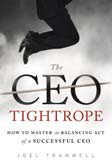The Best Metrics To Measure Performance
By Joel Trammell, author of The CEO Tightrope, CEO, Khorus
 Leaders must encourage constant improvement and consistently drive performance. The best way to do this is to ensure that all goals are tied to metrics that help predict business success. Selecting the correct measurement is critical.
Leaders must encourage constant improvement and consistently drive performance. The best way to do this is to ensure that all goals are tied to metrics that help predict business success. Selecting the correct measurement is critical.
The “ideal metric” possesses as many of the following characteristics as possible:
- Easily measurable
- Directly correlated with business performance
- Predictive of future business performance
- Comparable to the competition
- Isolated to factors controlled completely by the group that it is measuring.
No metric in the real world is perfect, but this list is a good place to start.
TURNOVER METRIC
Every manager in a company should be judged by the number of A-rated employees who leave the organization. I define A-rated performers as those ranked in the top 15 percent in the industry, considering their job and pay.
 Any time an A-rated employee leaves, the organization should conduct a thorough postmortem to understand why and what can be done to prevent further losses. When top performers leave for other jobs, it is often an early sign that things are going wrong in a department.
Any time an A-rated employee leaves, the organization should conduct a thorough postmortem to understand why and what can be done to prevent further losses. When top performers leave for other jobs, it is often an early sign that things are going wrong in a department.
SALES METRIC
Contrary to popular belief, total revenue is often NOT the most important metric for sales. First, it’s not predictive of future revenue. Second, sales groups are often impacted by conditions outside of their control (quality of product, economic conditions, etc.). Because low revenue doesn’t necessarily correlate to a bad team or poor effort, it’s not a great sales metric.
I believe the best metric for sales is the accuracy of revenue forecasts. As any good salesperson knows, making a sale is a process. The better you understand the process, the better you will be at maximizing the revenue possible within the given market conditions.
Therefore, the ability to predict revenue measures how good a sales team is at understanding the sales process. For example, at one of my former companies we expected the final sales numbers to be within 5 percent of the forecast at the beginning of the quarter. Building excellent forecasting into the company’s sales culture gave us a strong competitive advantage.
EMPLOYEE SATISFACTION METRIC
 Another metric I include for every department is employee satisfaction. I use the Gallup Q12, which is a 12-question survey of engagement created by the Gallup Organization. By giving this survey anonymously every six months, you can closely monitor employee engagement, which is crucial to success. This metric is easily measured, it’s predictive, and it’s somewhat reflective of factors unique to individual departments.
Another metric I include for every department is employee satisfaction. I use the Gallup Q12, which is a 12-question survey of engagement created by the Gallup Organization. By giving this survey anonymously every six months, you can closely monitor employee engagement, which is crucial to success. This metric is easily measured, it’s predictive, and it’s somewhat reflective of factors unique to individual departments.
As a leader, you want to build a business culture that is constantly seeking to understand and improve performance by measuring it intelligently. If people understand that they will be held to a high standard, the productivity of the company will be maximized. Choosing the right goals and metrics, and then verifying performance regularly, will help build that culture and a winning team.
